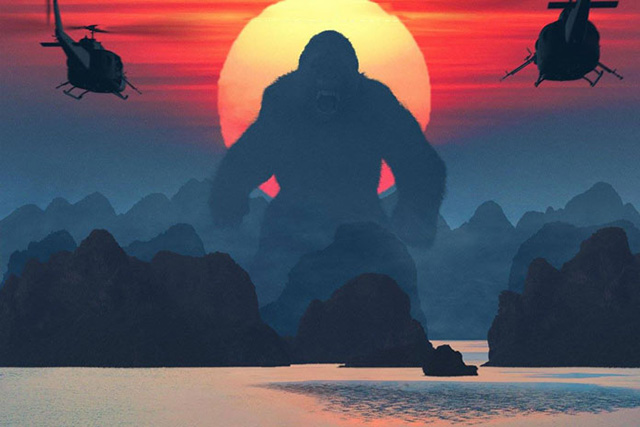Kong: Skull Island Is Just Monkeying Around

I saw the two big-budget franchise properties hitting theaters this week: Logan and Kong: Skull Island. Both feature rage-fueled, hairy characters protecting their adopted families from a world that hates them. One is daring, original, and brilliantly acted; the other has a giant CGI gorilla.
The latest remake of the 85-year-old Kong saga brings the silver screen’s most enduring ape to life yet again, this time in southeast Asia during the Vietnam War. The story hews closely to the requisite plot points of any Kong remake. A team of scientists and soldiers visits a mysterious, uncharted island where they encounter improbable creatures. Said creatures wreak havoc. A giant ape falls for a pretty blonde lady. There’s a climactic battle between good and evil. Lessons are learned, feelings are felt, credits roll. The obligatory visuals are all present: Kong escaping from massive chains; Kong cradling the girl in his enormous furry hand; Kong swatting pesky aircraft from the sky as they shoot at him.
With much of the action in previous Kong movies taking place in New York City, Kong: Skull Island takes a different approach: virtually the entire movie is set on the island. In the hands of better filmmakers, it could have been a brilliant move, capitalizing on the visceral dread of being trapped on an inaccessible jungle island with terrifying monsters. Instead, director Jordan Vogt-Roberts (Kings of Summer) and writers Dan Gilroy (The Bourne Legacy) and Max Borenstein (2014’s Godzilla) deliver a mish-mash of Vietnam War tropes, improbable beasts, and abused movie cliches — an unintentionally comic big-budget amalgam of previous Kong movies, Apocalypse Now, and Moby Dick.
Even then, it could have been a fun, campy movie with a giant ape battling subterranean lizard monsters set during the Vietnam War. Inexplicably, though, it turns into an Apocalypse Now knock-off featuring monsters simian, reptilian, and human, a PT boat cruising upriver, and a Colonel Kurtz analog. There’s even an indigenous tribe of silent, mysterious islanders that defers to the American army officer who lives in their village.
There are countless other Vietnam-era movie cliches: Creedence Clearwater songs, slow-motion Bell Huey helicopter rotors, Army grunts trudging through chest-high jungle rivers. Every time someone snaps a perfectly-staged photo, the through-the-lens color view irises to a grainy black & white snapshot. Even the opening credits are a variation on the “introduce backstory via spinning newspapers” gag.
Similarly, the characters are paper-thin cliches: the tough-as-nails Army colonel with something left to prove; the ex-British Special Forces soldier with a heart of gold; the take-no-crap American photojournalist who falls for the handsome leading man. They should have barcoded inventory labels on their backs to make it easy to put them back on the shelf in central casting.

Even a cast full of talented actors can’t do much with the poorly-written characters they’re playing. John Goodman does his best as the head of a shady government agency bent on uncovering Skull Island’s secret inhabitants for deeply personal reasons. Tom Hiddleston puts on his best concerned, world-weary face, along with a skin-tight t-shirt, but even a British accent can’t make his lines less absurd. Brie Larson alternates between wide-eyed delight at the island’s marvels and wide-eyed concern about the island’s monsters. Sam Jackson reprises his best-known role, Samuel L. Jackson. He all but said “there’s mother%$#^ apes on this mother%$#^ island.” John C. Reilly sinks his teeth into his role, an unhinged comic side-kick with a katana and an abiding love of the Chicago Cubs.
If Kong had white fur, he’d be Moby Dick. Like the whale in Melville’s classic, Kong has no equal on earth. Sam Jackson’s Colonel Packard is Ahab, so set on vengeance and human mastery over the natural world that he fixates on destroying his white whale, Kong, at all costs. That hubris is a major theme in Kong: Skull Island. While flying through the impenetrable storm that surrounds Skull Island, Packard makes an impromptu speech about Icarus. He pontificates that the U.S. Army won’t make Icarus’s mistake, oblivious to the irony of decrying hubris by saying they’re too smart for all that.
As Steven Spielberg famously learned with Jaws, slowly building up to the first time the audience sees the entire monster builds dramatic tension and pulls people into the story. Perhaps that applies more to malfunctioning sharks than to the King of Apes, who appears in his full, snarling glory in the movie’s first 15 minutes. He’s an impressive sight, with expressive eyes and bus-sized arms, but it robs him of any chance to make a truly dramatic entrance.
In the end, Kong: Skull Island throws too many ideas and pieces of better movies into the mix, hoping the massive CG-heavy action scenes gloss over the cliches, underwritten characters, and laughable dialog. The result is a movie squarely in the no man’s land between “too absurd to take seriously” and “not absurd enough to be delightfully campy.” It’s a few Sleestaks away from a self-serious Land of the Lost. It could easily be mistaken for a project turned in by a class of Columbia film school students studying Francis Ford Coppola who’d been given a $185 million budget and several A-list actors.
Ephemera:
* The Wonder Woman trailer still looks mostly amazing. Wonder Woman’s origin story looks powerful and compelling; Gal Godot breathes life into the iconic character. My concern is that the second half looks like Zack Snyder had a heavy hand in the writing and stylistic direction, full of fetished violence and massive ‘splosions.
* The post-credits scene, along with a tiny hint dropped early in the movie, explains a lot about Kong’s place in Legendary’s MonsterVerse.
Kong: Skull Island (Warner Brothers / Legendary Pictures; PG-13): C-



